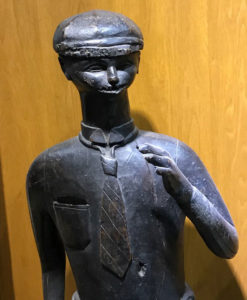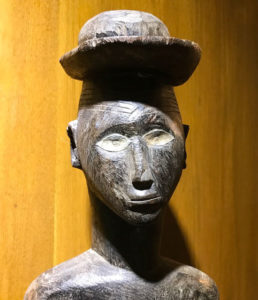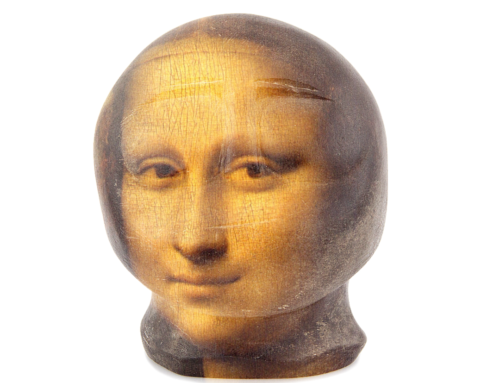After the Japanese collector and entrepreneur Yusaku Maezawa bought Jean-Michel Basquiat’s skull painting for $110.5 million at Sotheby’s auction the other day (the same picture sold for $19,000 in 1984!), he proudly posted on his Instagram account, “I am happy to announce that I just won this masterpiece. When I first encountered this painting, I was struck with so much excitement and gratitude for my love of art. I want to share that experience with as many people as possible.”

Standing Man
The painting is destined for a museum in his hometown of Chiba, Japan. However, Maezawa says he wants the Basquiat painting to travel internationally for others to appreciate it before it goes to Chiba.
$110.5 million!
The high price of this painting elevated Basquiat to the same league as Picasso and other superstars, and has curators feeling they missed the boat by not having Basquiat paintings in their museum collections. It seems that a few collectors with deep pockets can set the artistic level of the times.
Would Maezawa have bought this painting if there were any question about its authenticity, or if a colleague of Basquiat had been the artist? Same painting, but would anyone have paid even a few thousand dollars for it?
There are collectors who own valuable paintings, but display copies in their home and put the originals – the authentic pieces – in a vault for protection. Apparently they derive pleasure from knowing they own the original art, or maybe its just an investment, rather than enriching their life by living with the authentic work. Do they get the same pleasure from the replica as from the original, or would they if they didn’t also own the original? I doubt an art lover would be as excited as Maezawa was by seeing an exact replica of the Basquiat painting if they knew it wasn’t the real deal.

Sierra Leone Sculpture
I’m not disparaging the respect for authenticity; in fact, knowing that the art came directly from the hand of the artist matters a great deal to me and bonds me personally to the art. I feel a replica creates distance between the art and the viewer, losing impact in the chasm, like weathering a hurricane in a movie instead of in nature.
However, being an art collector, I have often asked myself why an original work should be valued so outrageously high – made into a shrine – while an indistinguishable, exact copy, or a similar work by an unknown artist, be relatively ignored by comparison.
What exactly do we mean by authentic? I agree that the Basquiat painting is impressive, but is $110.5 million largely hype, marketing, snobbism perhaps, directed by society?
The art critic, Blake Gopnik, cleverly argued in favor of fakes.
Admitting that such forgeries were an economic crime, he suggested that the ideas and innovations of the forged artist were what counted, not just the hands of the artist. Certainly many famous artists created their masterpieces with the assistance of students and other skilled artists. I wonder what the reaction would be if a lesser artist’s work were forged by a famous artist. Would that devalue the forged work as not authentic, or make it less significant than an original work by the famous artist? How much creative distortion would be needed before the reproduction was considered an authentic work of the master?
The question of authenticity in art goes beyond the hands that produced the work. What about derivative art that was influenced by others? Art critics and collectors try to assess the influence of one artist over another as they seek the original voice, an issue that can minimize the significance of a work of art despite its immediate appeal. What if the derivative work is more interesting or appealing than the original, influential art? Or what about two famous artists – say Picasso and Matisse – who influenced one another? Who gets the credit for what?
No creative work is entirely unique, just like newly evolved species don’t pop up without a preceding ancestor. Certainly much – almost all – superb art was produced in environments where groups of artists influenced each other: Michelangelo and the Italian Renaissance; Rembrandt and the seventeenth century Dutch Golden Age of painters; Renoir and the Impressionist movement. Japanese art influenced Van Gogh and African art influenced Picasso.

Sudan Sculpture
One of the most glaring marks of influence leading to creative art results from the mixing of cultures – art that attaches part of one culture to another. Wonderful examples are two wood sculptures, one from Sudan and the other from Sierra Leone, both made early in the 20th century. The sculptures are entirely original by dressing the African subjects in clothes that the colonists wore. A similar case exists for the Inuit stone sculpture, Standing Man, made in Inukjuak, Nunavut, in Arctic Northern Quebec on Hudson Bay around 1950. Standing Man is dressed in European clothes with his hands casually in the pockets, possibly representing a trader from the Hudson Bay Company. The originality of these fine works of ethnic art comes directly from the influences of another culture, despite that the artists are unknown.
Although literary arts are different from visual arts, it is of interest that playwrights Thomas Kyd and Christopher Marlowe and others influenced William Shakespeare, the most revered writer of all time. As for authenticity, debate still exists as to whether Shakespeare was really Shakespeare or someone else, and whether he was sole author of all his plays. No matter. The importance of artistry and originality trumps authenticity.
Thus, while authenticity establishes credibility and creates a bond between artist and viewer, as well as establishes mind-blowing market values, don’t minimize multiple outside influences that shape originality and play crucial roles in creativity and the emergence of new voices.






Leave A Comment